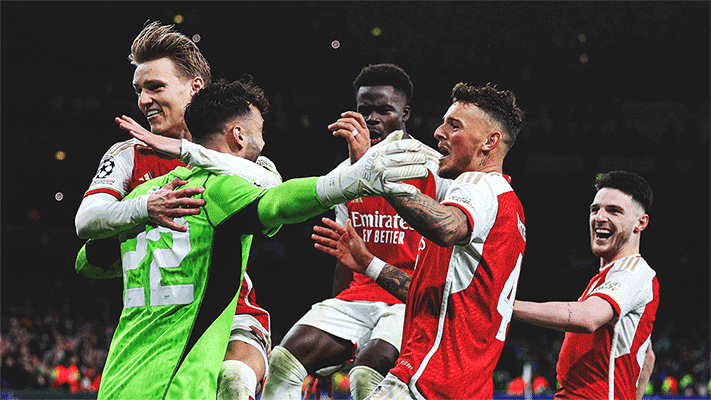When talking about Arsene Wenger’s first Premier League title, achieved in his first full season back in 1997/98, many fondly recall Arsenal’s fine defence.
The famous old back four of Lee Dixon, Steve Bould or Martin Keown, Tony Adams and Nigel Winterburn remained intact throughout the majority of the 1990s, and having been drilled relentlessly on the training ground under George Graham, remained a solid, cohesive unit in the early Wenger years.
"This campaign the defensive shape has been consistently excellent, and is somewhat old-school Arsenal"
But while the understanding between the back four was marvellous, Wenger was keen to give them extra protection. The signings of Patrick Vieira and Emmanuel Petit provided Arsenal with the Premier League’s most feisty, secure midfield combination. Whereas other sides preferred to use one defensive-minded midfielder alongside a more creative option, Vieira and Petit shielded Arsenal’s centre-backs together.
Their strength, in combination with the positional ability of the defenders, contributed to Arsenal’s sturdiness in central positions, effectively forming a solid ‘square’ with the two centre-backs.
While the current squad has much to achieve before replicating the success of the 1998 side, there is an encouraging feel about Arsenal’s defensive unit this season. Whereas the Gunners have often been criticised for conceding too many goals in recent seasons, this campaign the defensive shape has been consistently excellent, and is somewhat old-school Arsenal.
Only 10 goals have been conceded in 11 matches. Interestingly, three of these have been from penalties, another with a header straight from a corner, and another - Claudio Yacob’s header against West Brom - in the aftermath of a corner that wasn’t completely cleared. Clearly, defending set-pieces remains important, and the penalties arose from Arsenal errors, but for the Gunners to have conceded just five goals from open play in 11 matches remains highly impressive.

Per Mertesacker was on target against Stoke last season
The relationship between Per Mertesacker and Laurent Koscielny has clearly been a key part of the defensive plan. The two complement one another perfectly - Koscielny storms into tackles and sticks extremely tight to opponents, while Mertesacker is cool, calm and collected, and rarely lured out of position.
More crucial, however, has been Arsenal’s defensive shape as a whole. Capable of defending either deep on the edge of the penalty box, as against Dortmund, or much higher up the pitch against weaker opponents, Arsenal always seem to be tight, compact and disciplined in the centre of the pitch.
In midfield, Wenger has been able to call upon two defensive midfielders, Mathieu Flamini and Mikel Arteta, when required. As outlined previously, the options among Arsenal’s central midfielders are perhaps the best Wenger has ever possessed, and the Flamini-Arteta axis has proved particularly successful when required.
Against West Brom, for example, Arsenal’s average positions shows Arteta (8) and Flamini (20) solidly protecting the back four in central, defensive-minded positions.

Average position v West Brom
But Aaron Ramsey has also played his defensive role excellently. While he’s rightly received acclaim for his goal and assist figures so far this season, it’s equally impressive that the Welshman is currently the Premier League’s most prolific tackler, summing up his ability to get back into position and protect his defence.
Perhaps the 2-0 win over Liverpool summed it up - at the start of the second half, Arteta seemed a little isolated in front of the back four, with Ramsey scampering forward, but the Welshman justified his advanced positioning by firing in a superb second goal before spending the remainder of the game alongside Arteta.
In that match, the positions of Arsenal’s ball recoveries were interesting - they generally collected possession inside their own half, in central positions, illustrating how compact they remained in that zone.

Ball recoveries v Liverpool
While the partnerships between centre backs and central midfielders have been useful, equally crucial has been the relationship between the two duos. Arsenal have been excellent at minimising the space between the lines this season, with the defence and midfield remaining extremely close together. Communication has been vital in this respect: Mertesacker’s leadership qualities are well known, while Flamini is obviously a big talker on the pitch and Arteta has become one of Arsenal’s main leaders, too.
It’s extremely rare to see opposition playmakers find room to slide a through ball between Arsenal’s back four, and while they have conceded a reasonably high number of shots this season (seven sides have conceded fewer), a high proportion are from long range, such is Arsenal’s effectiveness at protecting the zone on the edge of the penalty box.
The 4-1 win over Norwich City was a fine example - all the Canaries’ efforts were from outside the penalty area. Eventually, Jonny Howson scored a fine goal to give Norwich hope, but Wenger will have been fairly satisfied that Howson’s strike, from the edge of the box, was their clearest sight of goal.

Norwich shots on goals v Arsenal
The fine organisation at the back means Arsenal are currently conceding their fewest goals per game since the 2007/08 campaign. The attacking fluidity and flair has captured the imagination, but the structure at the back has been equally important in putting Arsenal at the top of the table.
Copyright 2025 The Arsenal Football Club Limited. Permission to use quotations from this article is granted subject to appropriate credit being given to www.arsenal.com as the source.











